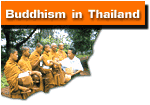 Chiang Mai Period Chiang Mai Period |
 While one of the Thai
tribes of the Chao Phraya River was founding Sukhothai
kingdom, another tribe in the north-western tableland,
called Lanna, was also successful in driving out the
Mons influence from the River Ping. In the nineteenth
Buddhist century King Meng-Rai of the ancient Chiang-San
dynasty was known to have defeated King Ye-Ma, the Mon
king of the town of Lamphun, and later built his capital
at Chiang Mai.During this time Theravada Buddhism of
Ceylon had been brought from their flourishing states
in the Mons country and in Sukhothai to the north-western
tableland, but was not able to take its firm roots there.
In the twentieth Buddhist century through the royal
order of King-Kue-Na, several Lankavangsa bhikkhus
both from Moulmein (Mau-Ta-Ma) and from Sukhothai were
invited to Chiang-Mai (750 km. north of Bangkok) to
preach their doctrine. Of these bhikkhus along with
their followers, one named Ananda was from the town
of Mua-Ta-Ma in the Mons country and the other called
Sumana was from Sukhothai. While one of the Thai
tribes of the Chao Phraya River was founding Sukhothai
kingdom, another tribe in the north-western tableland,
called Lanna, was also successful in driving out the
Mons influence from the River Ping. In the nineteenth
Buddhist century King Meng-Rai of the ancient Chiang-San
dynasty was known to have defeated King Ye-Ma, the Mon
king of the town of Lamphun, and later built his capital
at Chiang Mai.During this time Theravada Buddhism of
Ceylon had been brought from their flourishing states
in the Mons country and in Sukhothai to the north-western
tableland, but was not able to take its firm roots there.
In the twentieth Buddhist century through the royal
order of King-Kue-Na, several Lankavangsa bhikkhus
both from Moulmein (Mau-Ta-Ma) and from Sukhothai were
invited to Chiang-Mai (750 km. north of Bangkok) to
preach their doctrine. Of these bhikkhus along with
their followers, one named Ananda was from the town
of Mua-Ta-Ma in the Mons country and the other called
Sumana was from Sukhothai.
In the following century
(B.E. 2020 or 1477 AD) under the auspices of King Tilokara,
the thirteenth of Chieng Mai dynasty and under the leadership
of Khammadinna Thera, a general Council of bhikkhus
which lasted one year was convened at the Maha Bodhivong
Vihara. Practically this was the first Council held
in Thailand and reflected the intensive study of Buddhism
during the time. A collection of Pali texts, compiled
by the Thera (Elders) of that glorious age, are now
a pride of the those who wished to further their research
of Buddhism in the Pali language. Some such texts were
Abhidhammayojana, Mulakaccayanayojana. Vinayayojana,
Vessantaradipani and Mangalathadipani. In the following
(twenty-second) century the town was taken by the Burmese
and from time Chiang-Mai became a unhappy town alternately
torn by two superior powers i.e. Burma on her north
and the kingdom of Ayutthaya on her south.
|



 While one of the Thai
tribes of the Chao Phraya River was founding Sukhothai
kingdom, another tribe in the north-western tableland,
called Lanna, was also successful in driving out the
Mons influence from the River Ping. In the nineteenth
Buddhist century King Meng-Rai of the ancient Chiang-San
dynasty was known to have defeated King Ye-Ma, the Mon
king of the town of Lamphun, and later built his capital
at Chiang Mai.During this time Theravada Buddhism of
Ceylon had been brought from their flourishing states
in the Mons country and in Sukhothai to the north-western
tableland, but was not able to take its firm roots there.
In the twentieth Buddhist century through the royal
order of King-Kue-Na, several Lankavangsa bhikkhus
both from Moulmein (Mau-Ta-Ma) and from Sukhothai were
invited to Chiang-Mai (750 km. north of Bangkok) to
preach their doctrine. Of these bhikkhus along with
their followers, one named Ananda was from the town
of Mua-Ta-Ma in the Mons country and the other called
Sumana was from Sukhothai.
While one of the Thai
tribes of the Chao Phraya River was founding Sukhothai
kingdom, another tribe in the north-western tableland,
called Lanna, was also successful in driving out the
Mons influence from the River Ping. In the nineteenth
Buddhist century King Meng-Rai of the ancient Chiang-San
dynasty was known to have defeated King Ye-Ma, the Mon
king of the town of Lamphun, and later built his capital
at Chiang Mai.During this time Theravada Buddhism of
Ceylon had been brought from their flourishing states
in the Mons country and in Sukhothai to the north-western
tableland, but was not able to take its firm roots there.
In the twentieth Buddhist century through the royal
order of King-Kue-Na, several Lankavangsa bhikkhus
both from Moulmein (Mau-Ta-Ma) and from Sukhothai were
invited to Chiang-Mai (750 km. north of Bangkok) to
preach their doctrine. Of these bhikkhus along with
their followers, one named Ananda was from the town
of Mua-Ta-Ma in the Mons country and the other called
Sumana was from Sukhothai.